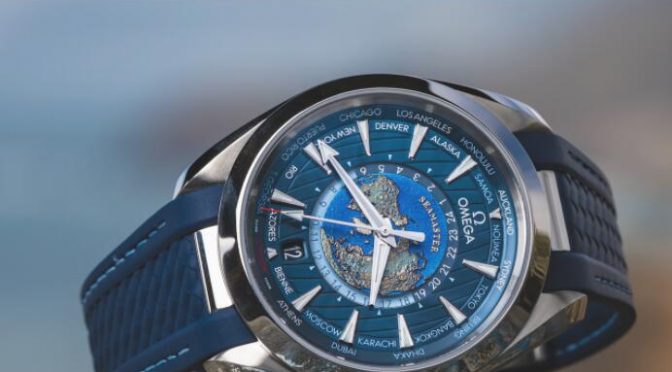
After the striking blue of the ocean and the relief map of the world’s continents, the next thing I noticed upon receiving this watch for review from Omega Seamaster Aqua Terra Worldtimer Master Chronometer was the city chosen to represent Central European Time. Bienne (Biel to its German-speaking denizens) is the home of Omega HQ and the seat of its parent company, the Swatch Group. The municipality is also known as Biel-Bienne, and is notable for the fact that its inhabitants are split between French and German speakers. Putting Bienne on the dial is a choice that ought to be significant for Omega fans, even if the much larger cities of Paris, Geneva, Berlin and Zurich were all passed over for this comparatively small Swiss municipality.
The Omega Seamaster Aqua Terra 150M Co-Axial Master Chronometer GMT Worldtimer 43MM, henceforth known as the Seamaster Aqua Terra Worldtimer (it’s in fact a worldtimer, not a GMT), is a sporty take on a classic complication that looks great while still managing to feel slightly unexpected in the Omega lineup. For me, Omega has always been mainly about the tool watches, namely the legendary Speedmaster chronograph and the Seamaster diver. Worldtimers, on the other hand, tend to be put forward by brands associated with luxury, a category that Omega has increasingly been comfortable operating in while maintaining its technical advantages. This unlimited model, available in both Sedna Gold and stainless steel, follows a platinum limited-edition worldtimer that Omega launched two years ago in a run of 87 pieces.
Look at the Caliber 8938 that powers the Seamaster Aqua Terra Worldtimer. It’s a well-engineered thing of beauty that demonstrates how far Omega has come as a watchmaker over the last 10 to 15 years. From near-universal implementation of the George Daniels co-axial escapement in its movements to the development and adoption of some of the strictest certification criteria in Switzerland, Omega has positioned itself, right alongside Rolex, at the very top of the watchmaking pyramid in terms of high-quality quality control at volume. There is just a ton of value on offer in every modern Omega movement, and it goes well beyond the nice Geneva waves in arabesque that decorate the rotor, plates and bridges.
Like many of Omega calibers currently in production, the 8938 is a Master Chronometer, which means that it has been chronometer certified by the the independent Swiss agency METAS and that it is hugely amagnetic, with the ability to resist magnetic fields up to 15,000 gauss. This latter feature alone makes this watch particularly well suited to a modern lifestyle surrounded by countless electronic devices. (And to the cockpit of a plane, for that matter, a logical place to find a multi-time-zone watch such as this one.)
As with most modern Omega automatic movements, cal. 8938 beats at a slightly unusual 25,200 vph, the more common rates being either 28,800 vph or 21,600 vph. Cal 8938 has a power reserve of 60 hours, which it derives from two barrels visible through the sapphire crystal exhibition caseback.
As with the vast majority of worldtimers, the execution of the dial has much to do with how this watch is likely to be received. While the world map here may not be crafted from cloissonné enamel or some other rare handcraft, it has a rich, textured, and vibrantly colored quality to it that makes for a striking presentation. It consists of a grade-five titanium plate that has been laser-ablated (sculpted) to create the crystal blue ocean as well as the relief engravings of the world’s major land masses. The map is surrounded by a 24-hour scale divided into night and day, and outward from there are the 24 place names. In addition to Bienne, these include New York, Chicago, Los Angeles, Rio, and Honolulu, to name just some. The applied markers are treated with blue-glowing lume, as are the hour, minute and seconds hands.
One potentially polarizing aspect of the Seamaster Aqua Terra Worldtimer’s design is the size of its case. It’s 43mm in diameter x 14.12mm thick, and that places it at the very high end of the range of watches that I tend to wear. Still, the styling is classic, with twisted, faceted lugs and a polished bezel. The watch may be large, but overall, the package is refined.
As configured here in a stainless-steel case and on a stainless-steel bracelet, the Seamaster Aqua Terra World Timer will set you back $9,100. If you forgo the bracelet in favor of the textured rubber strap, the price drops to $8,900. The gold variations are $36,200 on a Sedna gold bracelet and $22,700 on a leather strap. In addition to the case and bracelet, the movements in the Sedna gold references also have a Sedna gold rotor and balance bridge.